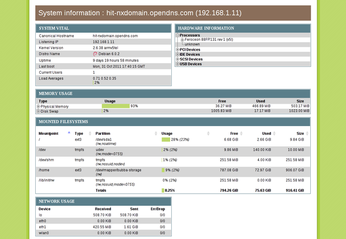Keep an Eye on Your Server with phpSysInfo

Productivity Sauce
Running a server on a local network opens a whole new world of possibilities. You can access your files and documents from multiple machines, stream media, host your own photo gallery or blog, and much more. This also means that you have to monitor your server to make sure it runs smoothly. There are quite a few server monitoring solutions out there, but most of them are overkill for keeping an eye on a single personal server. Enter phpSysInfo, a simple yet powerful script that displays essential system information in an easy-to-digest manner. The best part is that it requires virtually no configuration, and it can be deployed on your server in a matter of minutes. Grab the latest release of the software from the project's website, unpack the downloaded archive, rename the config.php.new file in the resulting directory to config.php and upload the entire phpsysinfo directory to your server. Point then the browser to http://127.0.0.1/phpsysinfo (replace 127.0.0.1 with the actual IP address or host name of your server) and you should see phpSysInfo in all its beauty.
The default phpSysInfo configuration displays all key information, but you can easily add more data points by editing the config.php file. All options available there contain brief but informative descriptions, so enabling and configuring the desired entries is easy. For example, to enable one or several bundled plugins edit the define('PSI_PLUGINS', false); line as in the example below:
define('PSI_PLUGINS', 'PS');phpSysInfo doesn't offer the flexibility or feature set of more advanced server monitoring solutions. But if you only want to be able to keep an eye on your personal server with a minimum of fuss, phpSysInfo is the perfect tool for the job.
Comments
comments powered by DisqusSubscribe to our Linux Newsletters
Find Linux and Open Source Jobs
Subscribe to our ADMIN Newsletters
Support Our Work
Linux Magazine content is made possible with support from readers like you. Please consider contributing when you’ve found an article to be beneficial.

News
-
OpenMandriva Lx 6.0 Available for Installation
The latest release of OpenMandriva has arrived with a new kernel, an updated Plasma desktop, and a server edition.
-
TrueNAS 25.04 Arrives with Thousands of Changes
One of the most popular Linux-based NAS solutions has rolled out the latest edition, based on Ubuntu 25.04.
-
Fedora 42 Available with Two New Spins
The latest release from the Fedora Project includes the usual updates, a new kernel, an official KDE Plasma spin, and a new System76 spin.
-
So Long, ArcoLinux
The ArcoLinux distribution is the latest Linux distribution to shut down.
-
What Open Source Pros Look for in a Job Role
Learn what professionals in technical and non-technical roles say is most important when seeking a new position.
-
Asahi Linux Runs into Issues with M4 Support
Due to Apple Silicon changes, the Asahi Linux project is at odds with adding support for the M4 chips.
-
Plasma 6.3.4 Now Available
Although not a major release, Plasma 6.3.4 does fix some bugs and offer a subtle change for the Plasma sidebar.
-
Linux Kernel 6.15 First Release Candidate Now Available
Linux Torvalds has announced that the release candidate for the final release of the Linux 6.15 series is now available.
-
Akamai Will Host kernel.org
The organization dedicated to cloud-based solutions has agreed to host kernel.org to deliver long-term stability for the development team.
-
Linux Kernel 6.14 Released
The latest Linux kernel has arrived with extra Rust support and more.


PhPSysInfo